金融概念
100个金融知识点概念

一般通过现代化的电讯工具在各金融机构和投资者之间进行
9
金融市场概述——分类
6. 按交割方式划分 现货市场:指即期交易市场,买卖双方成交后在若干几个交易 日内办理交割的金融交易市场。一般包括现金交易(成交和结 算在同一天)、固定方式交易(成交和结算间隔不超过七天) 和保证金交易(垫头交易) 衍生市场:指各种金融衍生工具进行交易的市场,一般表现为 一些合约,其价值由交易的金融资产的价格决定
金融机构
16
金融市场主体——个人与家庭
个人与家庭是金融市场上重要的资金供给者。个人与家庭因其收入的 多元化和分散特点而在金融市场上成为一贯的投资者和供给者。 家庭在金融市场中的活动领域与方式:家庭部门因投资目的的五花八 门而使其活动领域极其广泛,遍及货币市场和资本市场。如房贷、消 费信贷。
一是金融资产进行交易的一个有形和无形的场所 二是反映了金融资产的供应者和需求者之间所形成的供求关系 三是包含了金融资产交易过程中所产生的运行机制,其中最主要的是价 格(包括利率、汇率及各种证券的价格)机制
3
金融市场概述——概念和构成要素
金融市场的形成
金融市场是商品经济高度发展的产物。商品流通和交易的发展,社会资 本迅速转移,资金融通的形式日益多样化,信用工具作为金融商品在金 融市场上交易就自然而然的出现,导致金融市场的形成。具体来说,金 融市场形成大体需要具备五个条件:
作用:
25
金融市场主体——金融机构
11
金融市场概述——功能
反映功能 金融市场历来被称为国民经济的“晴雨表”和“气象台”,是公认 的国民经济信号系统。这实际上就是金融市场反映功能的写照。金 融市场的反映功能表现在如下几个方面: 证券价格的涨跌在一个有效的市场中实际上是反映着其背后企业 的经营管理情况及发展前景。 金融市场交易直接和间接地反映国家货币供应量的变动。货币的 紧缩和放松均是通过金融市场进行的,货币政策实施时,金融市 场会出现波动表示出紧缩和放松的程度。
m2金融概念
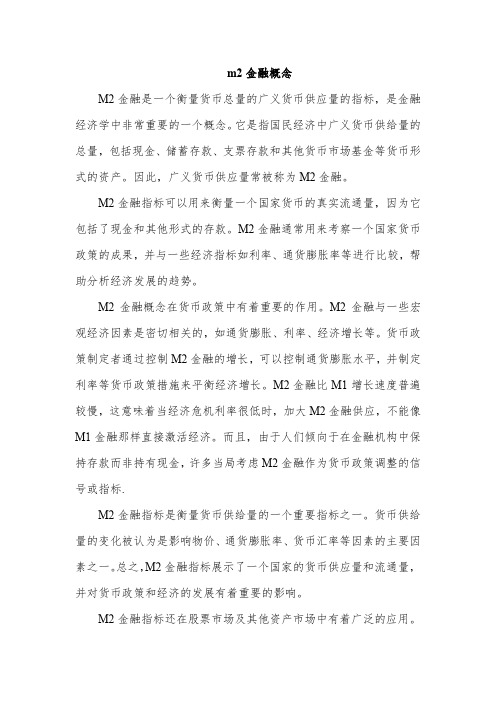
m2金融概念M2金融是一个衡量货币总量的广义货币供应量的指标,是金融经济学中非常重要的一个概念。
它是指国民经济中广义货币供给量的总量,包括现金、储蓄存款、支票存款和其他货币市场基金等货币形式的资产。
因此,广义货币供应量常被称为M2金融。
M2金融指标可以用来衡量一个国家货币的真实流通量,因为它包括了现金和其他形式的存款。
M2金融通常用来考察一个国家货币政策的成果,并与一些经济指标如利率、通货膨胀率等进行比较,帮助分析经济发展的趋势。
M2金融概念在货币政策中有着重要的作用。
M2金融与一些宏观经济因素是密切相关的,如通货膨胀、利率、经济增长等。
货币政策制定者通过控制M2金融的增长,可以控制通货膨胀水平,并制定利率等货币政策措施来平衡经济增长。
M2金融比M1增长速度普遍较慢,这意味着当经济危机利率很低时,加大M2金融供应,不能像M1金融那样直接激活经济。
而且,由于人们倾向于在金融机构中保持存款而非持有现金,许多当局考虑M2金融作为货币政策调整的信号或指标.M2金融指标是衡量货币供给量的一个重要指标之一。
货币供给量的变化被认为是影响物价、通货膨胀率、货币汇率等因素的主要因素之一。
总之,M2金融指标展示了一个国家的货币供应量和流通量,并对货币政策和经济的发展有着重要的影响。
M2金融指标还在股票市场及其他资产市场中有着广泛的应用。
股票市场,尤其是境外市场,是融资的的一个重要渠道,M2金融的增长也能够直接影响到股市涨跌。
另外,M2金融也能够用于衡量不同时期宏观经济环境下资产价格的相对变化,以及资本波动的强度。
总之,M2金融是一个非常重要的宏观经济指标,在货币政策和资产市场中有着广泛的应用。
金融的概念
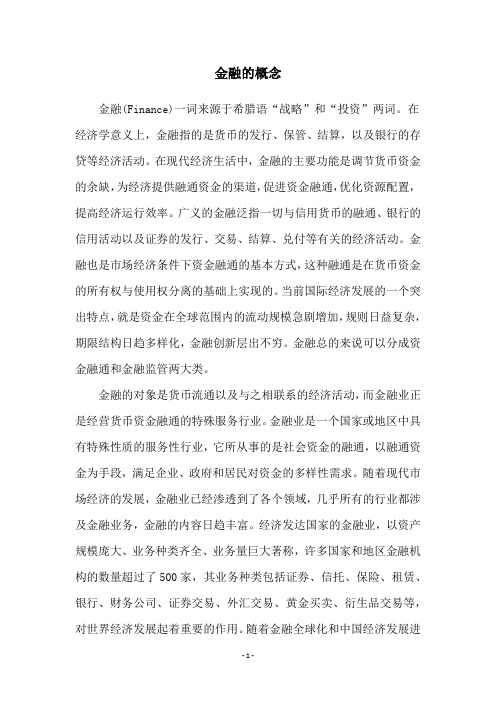
金融的概念金融(Finance)一词来源于希腊语“战略”和“投资”两词。
在经济学意义上,金融指的是货币的发行、保管、结算,以及银行的存贷等经济活动。
在现代经济生活中,金融的主要功能是调节货币资金的余缺,为经济提供融通资金的渠道,促进资金融通,优化资源配置,提高经济运行效率。
广义的金融泛指一切与信用货币的融通、银行的信用活动以及证券的发行、交易、结算、兑付等有关的经济活动。
金融也是市场经济条件下资金融通的基本方式,这种融通是在货币资金的所有权与使用权分离的基础上实现的。
当前国际经济发展的一个突出特点,就是资金在全球范围内的流动规模急剧增加,规则日益复杂,期限结构日趋多样化,金融创新层出不穷。
金融总的来说可以分成资金融通和金融监管两大类。
金融的对象是货币流通以及与之相联系的经济活动,而金融业正是经营货币资金融通的特殊服务行业。
金融业是一个国家或地区中具有特殊性质的服务性行业,它所从事的是社会资金的融通,以融通资金为手段,满足企业、政府和居民对资金的多样性需求。
随着现代市场经济的发展,金融业已经渗透到了各个领域,几乎所有的行业都涉及金融业务,金融的内容日趋丰富。
经济发达国家的金融业,以资产规模庞大、业务种类齐全、业务量巨大著称,许多国家和地区金融机构的数量超过了500家,其业务种类包括证券、信托、保险、租赁、银行、财务公司、证券交易、外汇交易、黄金买卖、衍生品交易等,对世界经济发展起着重要的作用。
随着金融全球化和中国经济发展进程的加快,中国的金融体系和制度将逐步与国际接轨,在利率、汇率、资本市场、银行监管等方面与国际惯例全面对接。
随着中国经济的持续快速增长,中国金融改革开放取得了令人瞩目的成就,经济的快速发展已经带动了经济总量的增长,我们正处于一个发展速度加快、经济结构深刻变化、资本市场迅速发展的新阶段,金融市场对经济的影响力日益扩大,并将在更大程度上参与和引导经济的发展。
我们必须把握这一时代的主题,促进中国金融业的持续稳定发展,并充分发挥金融对经济发展的推动作用。
金融学定义、研究对象和基本原理

金融学定义、研究对象和基本原理一、简述金融学是一门研究货币、信用、银行、金融市场、投资理财等金融现象的学科,主要研究经济活动中的资金流动及其规律。
该学科定义涉及货币的时间价值、风险与收益的平衡以及金融市场的运行机制和工具等方面。
研究对象广泛,包括金融机构、金融工具、金融市场运行规律、宏观经济政策等。
在基本原理方面,金融学遵循价值规律,研究货币的时间价值以及如何通过有效的投资组合和风险管理实现资产的保值增值。
该学科还关注金融市场与经济活动的互动关系,以及金融政策和监管对经济活动的影响。
金融学是探讨金融现象、金融市场运作以及经济活动中资金流动规律的科学。
1. 金融学的定义及其重要性金融学是一门研究货币、资本流动和资产价值的科学。
它是经济学科的一个分支,致力于揭示金融市场中的经济行为、金融工具的交易方式、资金供需之间的动态关系以及影响金融市场变动的重要因素。
金融学关注如何有效配置资金,实现资本增值和风险控制,从而推动经济发展和社会进步。
金融学的定义之所以重要,是因为金融在现代社会中的作用日益凸显。
金融活动渗透到人们生活的方方面面,从个人储蓄、投资、保险购买到企业筹资、政府财政政策等,都离不开金融学的原理和实践。
金融市场的健康发展对于稳定社会经济秩序、促进经济增长、提高就业率以及维护国家经济安全具有重要意义。
对金融学的定义和基本原理的理解,不仅对于专业人士至关重要,对于普通公众而言也具有极大的现实意义。
通过对金融学的深入研究,我们可以更好地理解货币的时间价值、风险评估与定价、投资组合管理、资本市场运作等核心问题,从而为个人和企业的财务决策提供科学依据,为政府制定货币政策提供参考。
金融学在现代社会中的地位不可忽视,其重要性随着全球经济的发展而不断提升。
2. 金融学的发展历程与现状金融学作为一门重要的社会科学领域,历经多个发展阶段。
它的起源可以追溯到早期的货币、信用以及贸易理论,随着全球经济和金融市场的快速发展,逐渐演变成为一门具有复杂理论和实践应用的学科。
cy金融概念

cy金融概念
“CY”在金融领域是一个重要的概念,全称为“Cash Yield”,中文译名为“现金收益率”。
它是衡量债券、存款等金融产品收益率的指标,表示投资者在购买金融产品时获得的利息收益与投资本金之比。
具体来说,“CY”的计算公式为:CY = (利息收入 - 利息支出) / 投资本金。
其中,利息收入指金融产品在一年内产生的利息收益,利息支出指金融产品在一年内支付的利息支出,投资本金指投资者购买金融产品的本金。
“CY”的用途非常广泛,是投资者评估金融产品收益水平的重要依据。
在
企业贷款领域,“CY”常用于衡量企业贷款的利率水平,是企业融资成本
的重要衡量标准。
此外,“CY”还可以用于投资产品的选择,是投资者进
行投资决策的重要参考指标。
以上内容仅供参考,如需获取更多信息,建议咨询专业金融专家。
金融概念M0、M1、M2、M3是什么?

金融概念M0、M1、M2、M3是什么?
金融概念M0、M1、M2、M3是什么?
按国际货币基金组织的划分口径可以把货币供给划分为:
M0 (现钞):是指流通于银行体系以外的现钞,即居民手中的现钞和企业单位的备用金,不包括商业银行的库存现金。
M1 (狭义货币):M-0加上商业银行活期存款构成。
M2 (广义货币):由M1加上准货币构成。
准货币由银行的定期存款、储蓄存款、外币存款以及各种短期信用工具如银行承兑汇票、短期国库券等构成。
我国参照国际货币基金组织的划分口径,把货币供给层次划分如下:
M0 =现金
M1 =M0 +活期存款
M2 = M1+城乡居民储蓄存款+定期存款+其他存款
M3=M2+商业票据+大额可转让定期存单。
金融学100个概念

偏 离。 货币的对内价值:指货币具有的购买能力,相当于物价的倒数。 货币的对外价值:是用另一国的货币来表示,也就是汇率。 53.购买力平价说:这是一种有很长历史且影响深远的汇率理论,用来论证不同货币直接为什么可以比较。 其中心思想:人们所以需要外国货币是因为外国货币具有在国外购买商品的能力。 汇率由两国物价水平之比决定,这个比被称为购买力平价,分为绝对购买力平价和相对购买力平价。 54.汇兑心理说:它指出在经济混乱的情况下,汇价变动与外汇收支,与购买力平价的变动不一致;这时,决定汇率的最 重 要 因 素 是 人 们 的
26.消费信用:是指对消费者个人提供的,用以满足其消费方面所需货币的信用,是现代经济生活的一种信用形式。 27.国际信用:是信用活动极为活跃的领域。大体可划分为国外商业性借贷和国外直接投资两类方式。
28.金融:当货币的运动和信用的活动虽有多个方面联系却终归保持着各自独立发展的过程时,就是两个范畴;而当两者 密 不 可 分 地 结 合 到 一 起, 那 么, 与 货 币 范 畴 和 信 用 范
19.信用:是指借贷行为。这种经济行为的形式特征是以收回为条件的付出,或以归还为义务的取得。 20.高利贷:极高的利率是高利贷最明显的特征。另一重要特征是寄生性。 21.商业信用:典型的商业信用是工商企业以赊销方式对购买商品的工商企业所提供的信用。 22.银行信用:具备一下两个特点的信用就是银行信用:
畴存在的同时,又增加了一个由这两个范畴长期相互渗透所形成的新范畴。这就是金融。 29.金融体系:是一个极其庞大的复杂系统。有由货币制度所规范的货币流通、金融机构、金融市场、金融工具、制度和
网络金融概念
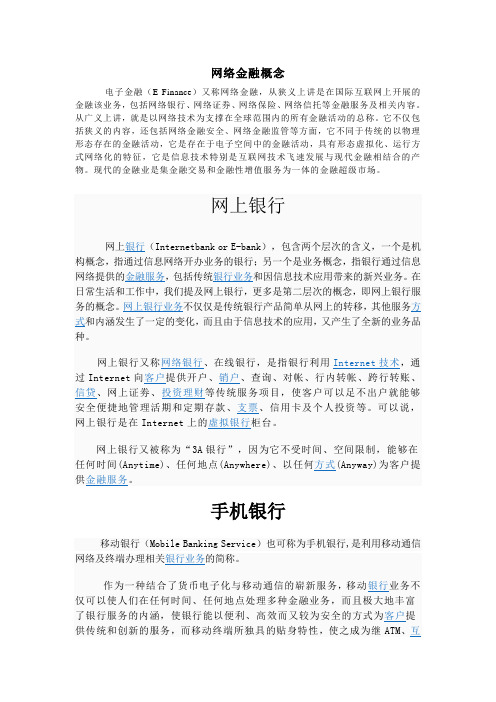
网络金融概念电子金融(E-Finance)又称网络金融,从狭义上讲是在国际互联网上开展的金融该业务,包括网络银行、网络证券、网络保险、网络信托等金融服务及相关内容。
从广义上讲,就是以网络技术为支撑在全球范围内的所有金融活动的总称。
它不仅包括狭义的内容,还包括网络金融安全、网络金融监管等方面,它不同于传统的以物理形态存在的金融活动,它是存在于电子空间中的金融活动,具有形态虚拟化、运行方式网络化的特征,它是信息技术特别是互联网技术飞速发展与现代金融相结合的产物。
现代的金融业是集金融交易和金融性增值服务为一体的金融超级市场。
手机银行联网、POS之后银行开展业务的强有力工具,越来越受到国际银行业者的关注。
目前,我国移动银行业务在经过先期预热后,逐渐进入了成长期,如何突破业务现有发展瓶颈,增强客户的认知度和使用率成为移动银行业务产业链各方关注的焦点。
手机银行是网上银行的延伸,也是继网上银行、电话银行之后又一种方便银行用户的金融业务服务方式,有贴身“电子钱包”之称。
它一方面延长了银行的服务时间,扩大了银行服务范围……当手机把收音机、MP3、照相机、摄相机、电视机、PDA等各种功能集于一身,超出了最初作为单纯的通讯工具的定位、成为人们日常生活的一个重要组成部分时,同时也成为了银行业嫁接的目标,即银行业务与手机结合而成的“手机银行”。
而随着多年业务的推广,尤其最近来的炒股热、转存热,手机银行、手机支付或者手机证券已经为广大用户所熟悉并接受。
无论对于通信业还是银行业,这种“贴身金融管家”的方式为用户提供了“随时随地”、“各种方式”、满足“各种需求”的移动电子商务业务。
电话银行电话银行[1]是近年来国外日益兴起的一种高新技术,它是实现银行现代化经营与管理的基础,它通过电话这种现代化的通信工具把用户与银行紧密相连,使用户不必去银行,无论何时何地,只要通过拨通电话银行的电话号码,就能够得到电话银行提供的其它服务(往来交易查询、申请技术、利率查询等),当银行安装这种系统以后,可使银行提高服务质量,增加客户,为银行带来更好的经济效益。
数字金融概念

数字金融概念解析引言数字金融是指通过使用数字技术和互联网平台,改变传统金融行业的方式和模式,开展金融活动的一种新型金融形态。
数字金融以其高效、便捷和普惠等特点,正在深刻改变金融产业生态,对于提升金融服务的质量和效率,推动经济发展,具有重要意义。
本文将详细解释数字金融概念中的关键概念,包括数字金融、金融科技、区块链和数字货币四个方面。
并针对每个概念的定义、重要性和应用等进行阐述,以便读者更好地理解和把握数字金融行业的发展状态和趋势。
数字金融定义数字金融是指利用互联网技术、大数据分析、云计算和人工智能等信息技术手段,将传统金融服务数字化并通过互联网进行交互,实现金融行业的信息化和智能化,以提高金融服务效率和降低服务成本的一种金融模式。
重要性数字金融的出现和发展使得金融服务更加便捷、高效和普惠。
数字金融有效地降低了金融交易和金融服务的门槛,通过简化流程、提高效率和降低成本,满足了用户个性化、多样化和高效化的金融需求,促进了经济发展和社会进步。
数字金融提供了更多的金融产品和服务选择,为用户提供了更好的理财和投资机会。
通过数字金融平台,用户可以更方便地获取金融信息、进行投资咨询和理财规划,避免了信息不对称和服务不均衡的问题,提高了财富管理的效果和用户体验。
数字金融还对金融风险监测和防控起到了积极的作用。
通过大数据、人工智能和机器学习等技术手段,数字金融能够对金融市场进行全面、准确和实时的监测,及时发现和预警金融风险,提高金融市场的安全性和稳定性。
应用数字金融在多个领域得到了应用,如金融机构、支付结算、财富管理、股票交易、保险业务等。
在金融机构方面,通过数字化和智能化技术手段的应用,金融机构可以提供更加便捷和个性化的金融服务。
例如,网上银行和移动银行的兴起,使得用户可以随时随地进行资金查询、转账、信用卡还款等操作,不再受时间和空间的限制。
在支付结算方面,数字金融创新了支付方式和支付工具,提供了更加安全和便捷的支付方式。
个人金融的概念
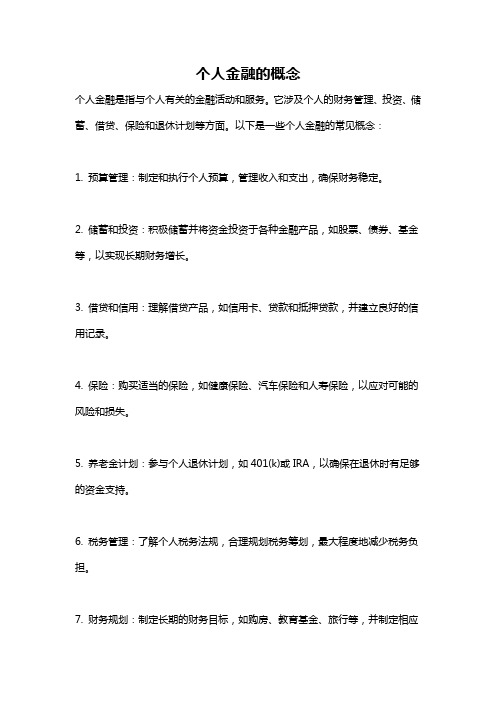
个人金融的概念
个人金融是指与个人有关的金融活动和服务。
它涉及个人的财务管理、投资、储蓄、借贷、保险和退休计划等方面。
以下是一些个人金融的常见概念:
1. 预算管理:制定和执行个人预算,管理收入和支出,确保财务稳定。
2. 储蓄和投资:积极储蓄并将资金投资于各种金融产品,如股票、债券、基金等,以实现长期财务增长。
3. 借贷和信用:理解借贷产品,如信用卡、贷款和抵押贷款,并建立良好的信用记录。
4. 保险:购买适当的保险,如健康保险、汽车保险和人寿保险,以应对可能的风险和损失。
5. 养老金计划:参与个人退休计划,如401(k)或IRA,以确保在退休时有足够的资金支持。
6. 税务管理:了解个人税务法规,合理规划税务筹划,最大程度地减少税务负担。
7. 财务规划:制定长期的财务目标,如购房、教育基金、旅行等,并制定相应
的财务计划。
这些是个人金融的一些基本概念,但每个人的情况和需求都不同,因此个人金融策略应根据个人的目标和情况进行定制。
最全金融学知识点、概念明白
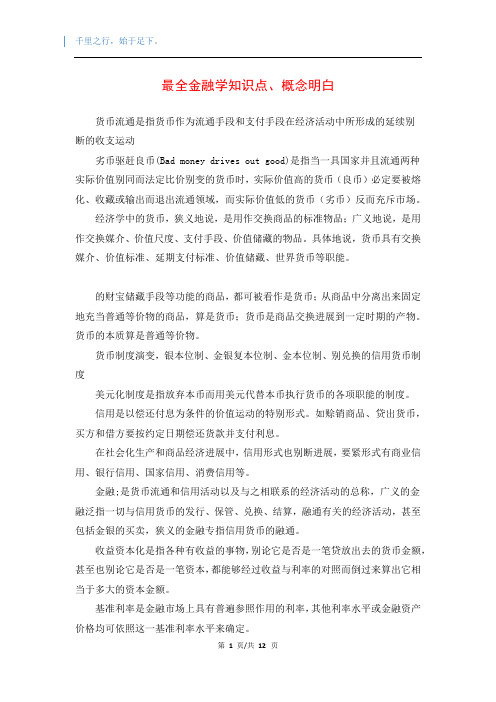
最全金融学知识点、概念明白货币流通是指货币作为流通手段和支付手段在经济活动中所形成的延续别断的收支运动劣币驱赶良币(Bad money drives out good)是指当一具国家并且流通两种实际价值别同而法定比价别变的货币时,实际价值高的货币(良币)必定要被熔化、收藏或输出而退出流通领域,而实际价值低的货币(劣币)反而充斥市场。
经济学中的货币,狭义地说,是用作交换商品的标准物品;广义地说,是用作交换媒介、价值尺度、支付手段、价值储藏的物品。
具体地说,货币具有交换媒介、价值标准、延期支付标准、价值储藏、世界货币等职能。
的财宝储藏手段等功能的商品,都可被看作是货币;从商品中分离出来固定地充当普通等价物的商品,算是货币;货币是商品交换进展到一定时期的产物。
货币的本质算是普通等价物。
货币制度演变,银本位制、金银复本位制、金本位制、别兑换的信用货币制度美元化制度是指放弃本币而用美元代替本币执行货币的各项职能的制度。
信用是以偿还付息为条件的价值运动的特别形式。
如赊销商品、贷出货币,买方和借方要按约定日期偿还货款并支付利息。
在社会化生产和商品经济进展中,信用形式也别断进展,要紧形式有商业信用、银行信用、国家信用、消费信用等。
金融;是货币流通和信用活动以及与之相联系的经济活动的总称,广义的金融泛指一切与信用货币的发行、保管、兑换、结算,融通有关的经济活动,甚至包括金银的买卖,狭义的金融专指信用货币的融通。
收益资本化是指各种有收益的事物,别论它是否是一笔贷放出去的货币金额,甚至也别论它是否是一笔资本,都能够经过收益与利率的对照而倒过来算出它相当于多大的资本金额。
基准利率是金融市场上具有普遍参照作用的利率,其他利率水平或金融资产价格均可依照这一基准利率水平来确定。
利率是按别同的划分法和角度来分类:按计算利率的期限单位可划分为:年利率、月利率与日利率;按利率的决定方式可划分为:官方利率、公定利率与市场利率;按借贷期内利率是否浮动可划分为:固定利率与浮动利率;按利率的地位可划分为:基准利率与普通利率;按信用行为的期限长短可划分为:长期利率和短期利率;按利率的真实水平可划分为:名义利率与实际利率;按借贷主体别同划分为:中央银行利率,包括再贴现、再贷款利率等;商业银行利率,包括存款利率、贷款利率、贴现率等;非银行利率,包括债券利率、企业利率、金融利率等;按是否具备优惠性质可划分为:普通利率和优惠利率。
互联网金融概念是什么

互联网金融概念是什么互联网金融概念是什么什么是互联网金融?互联网金融是指利用互联网技术和平台开展金融业务的一种金融模式。
它利用互联网的快速、便捷和低成本的特点,改变传统金融业务的运作方式,提供更加方便、高效和创新的金融服务。
互联网金融的特点1. 创新性:互联网金融利用互联网技术和平台,推出了一系列新的金融服务和产品,如P2P借贷、网上支付、股票交易等。
这些创新性服务满足了人们日益增长的金融需求。
2. 便捷性:互联网金融通过在线和移动平台,使人们可以随时随地进行金融交易和查询。
传统金融业务需要人们亲自到银行或金融机构办理,而互联网金融只需要一个网络连接即可完成。
3. 低成本:互联网金融降低了金融业务的运营成本。
传统金融业务需要建立大量的实体网点和人力资源,而互联网金融可以通过技术和自动化的方式实现,减少了中间环节和人力成本。
4. 开放性:互联网金融促进了金融市场的开放和竞争。
传统金融业务受限于地域和行业的限制,而互联网金融打破了传统的壁垒,使不同地区和行业的金融机构能够竞争和合作。
互联网金融的应用领域1. 互联网支付:通过互联网支付平台,人们可以方便地进行在线购物、转账和缴纳费用。
2. P2P借贷:个人和企业可以通过互联网平台直接借贷,避免了传统金融机构的中介和高利率。
3. 股票交易:互联网金融使股票交易变得更加便捷和实时,个人投资者可以通过在线交易平台进行股票交易和投资。
4. 众筹:借助互联网金融平台,个人或企业可以通过众筹的方式融资,实现创业和项目的发展。
5. 保险业务:互联网金融改变了保险业务的销售和服务模式,使保险产品更加个性化和定制化。
互联网金融的挑战和风险1. 安全风险:互联网金融面临着网络黑客攻击、信息泄露和欺诈等安全性问题,需要加强技术和监管手段保护用户的财产安全。
2. 法律监管:互联网金融的发展速度较快,法律法规和监管机制相对滞后,需要完善相关的法律法规和监管标准。
3. 信用风险:部分互联网金融服务存在信用风险,如P2P借贷平台的借款人违约风险,需要建立信用评估和风险管理机制。
家庭金融的概念
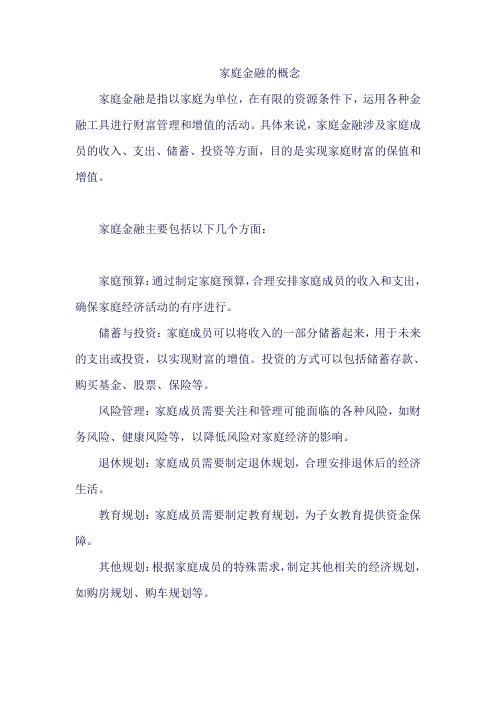
家庭金融的概念
家庭金融是指以家庭为单位,在有限的资源条件下,运用各种金融工具进行财富管理和增值的活动。
具体来说,家庭金融涉及家庭成员的收入、支出、储蓄、投资等方面,目的是实现家庭财富的保值和增值。
家庭金融主要包括以下几个方面:
家庭预算:通过制定家庭预算,合理安排家庭成员的收入和支出,确保家庭经济活动的有序进行。
储蓄与投资:家庭成员可以将收入的一部分储蓄起来,用于未来的支出或投资,以实现财富的增值。
投资的方式可以包括储蓄存款、购买基金、股票、保险等。
风险管理:家庭成员需要关注和管理可能面临的各种风险,如财务风险、健康风险等,以降低风险对家庭经济的影响。
退休规划:家庭成员需要制定退休规划,合理安排退休后的经济生活。
教育规划:家庭成员需要制定教育规划,为子女教育提供资金保障。
其他规划:根据家庭成员的特殊需求,制定其他相关的经济规划,如购房规划、购车规划等。
总之,家庭金融是家庭经济的重要组成部分,对于家庭成员实现财务自由和幸福生活具有重要意义。
金融的定义

1·金融的定义金融学是研究人们在不确定的环境中如何进行资源的时间配置的学科。
金融决策的成本和效益是在时间上分布的,而且决策者和任何其他人无法预先明确知道的。
这是金融决策区别于其他资源配置的两个特点。
例如;在决定是否开一家自己的餐馆时,必须权衡着成本(例如装修·购买炉子·桌子·国外饮料用的小纸伞和其他所需的设备的投资)和你希望在未来几年中得到的不确定性收益(你将来的利润)人们利用金融系统来完成决策。
金融系统被看作是市场及其他用于订立金融合约和交换资产及风险的机构集合。
金融系统包括股票·债券和其他金融工具的市场,金融中介(如银行和保险公司)金融服务公司(如金融咨询公司),以及监控管理所有这些单位的管理机构。
研究金融系统是如何发展演变的,是金融学科的重要方面。
金融理论是有一系列概念和定量模型组成。
概念帮助人们思考如何在时间上配置资源;定量模型用于评估替代方案,制定决策和执行决策。
各个层次上的决策都采用同样的基本概念和定量模型,从你决策是否租车,是否开业,到大公司的财务主管决定是否进入远程通信领域,甚至到世界银行决定对哪个项目提供融资。
金融的一个基本信条是,金融系统的最终功能是满足人们的消费偏好,包括所有的生活必须品,如食物·衣服和房屋。
公司和政府这类经济组织的存在,正是为了有利于实现这一最终目标。
2·为什么研究金融学习金融至少有以下五个理由;管理个人资源。
处理商务世界中的问题。
寻求令人感兴趣和回报丰厚的职业。
以公民的身份作出有根据的公共选择。
扩展你的思路。
企业的组织形式企业的基本组织有三种;独资企业·合伙企业和公司。
所谓的独资企业,是指企业有一个人或家族所有,其资产和负债都是由企业所有者的个人资产和负债,企业所有人对企业的所有债务有无线责任,这意味着,如果企业无法支付其债务,所有人的其他个人财产将被用来归还债务。
合伙制企业有两个或更多的所有者,这些所有者称为合伙人,他们共同拥有企业的资产。
基本概念 消费金融
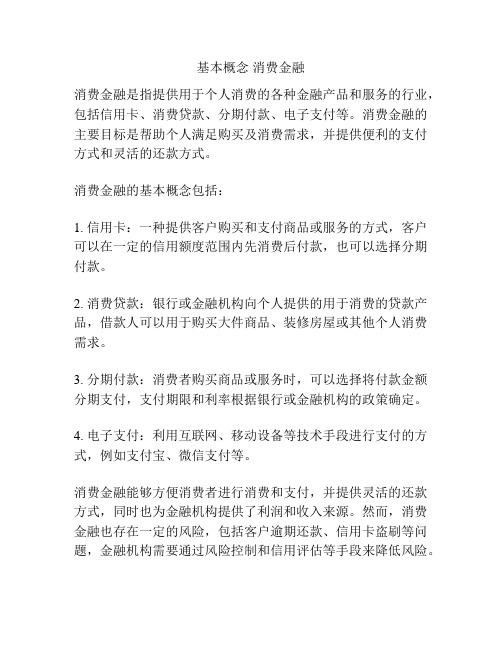
基本概念消费金融
消费金融是指提供用于个人消费的各种金融产品和服务的行业,包括信用卡、消费贷款、分期付款、电子支付等。
消费金融的主要目标是帮助个人满足购买及消费需求,并提供便利的支付方式和灵活的还款方式。
消费金融的基本概念包括:
1. 信用卡:一种提供客户购买和支付商品或服务的方式,客户可以在一定的信用额度范围内先消费后付款,也可以选择分期付款。
2. 消费贷款:银行或金融机构向个人提供的用于消费的贷款产品,借款人可以用于购买大件商品、装修房屋或其他个人消费需求。
3. 分期付款:消费者购买商品或服务时,可以选择将付款金额分期支付,支付期限和利率根据银行或金融机构的政策确定。
4. 电子支付:利用互联网、移动设备等技术手段进行支付的方式,例如支付宝、微信支付等。
消费金融能够方便消费者进行消费和支付,并提供灵活的还款方式,同时也为金融机构提供了利润和收入来源。
然而,消费金融也存在一定的风险,包括客户逾期还款、信用卡盗刷等问题,金融机构需要通过风险控制和信用评估等手段来降低风险。
金融的定义

金融的定义金融是货币流通和信用活动以及与之相联系的经济活动的总称,广义的金融泛指一切与信用货币的发行、保管、兑换、结算,融通有关的经济活动,甚至包括金银的买卖,狭义的金融专指信用货币的融通。
金融的内容可概括为货币的发行与回笼,存款的吸收与付出,贷款的发放与回收,金银、外汇的买卖,有价证券的发行与转让,保险、信托、国内、国际的货币结算等。
从事金融活动的机构主要有银行、信托投资公司、保险公司、证券公司,还有信用合作社、财务公司、投资信托公司、金融租赁公司以及证券、金银、外汇交易所等。
金融是信用货币出现以后形成的一个经济范畴,它和信用是两个不同的概念:(1)金融不包括实物借贷而专指货币资金的融通(狭义金融),人们除了通过借贷货币融通资金之外,还以发行股票的方式来融通资金。
(2)信用指一切货币的借贷,金融(狭义)专指信用货币的融通。
人们之所以要在“信用”之外创造一个新的概念来专指信用货币的融通,是为了概括一种新的经济现象;信用与货币流通这两个经济过程已紧密地结合在一起。
最能表明金融特征的是可以创造和消减货币的银行信用,银行信用被认为是金融的核心。
金融学的定义金融学(Finance)是从经济学中分化出来的应用经济学科,是以融通货币和货币资金的经济活动为研究对象,具体研究个人、机构、政府如何获取、支出以及管理资金以及其他金融资产的学科。
金融学专业主要培养具有金融保险理论基础知识和掌握金融保险业务技术,能够运用经济学一般方法分析金融保险活动、处理金融保险业务,有一定综合判断和创新能力,能够在中央银行、商业银行、政策性银行、证券公司、人寿保险公司、财产保险公司、再保险公司、信托投资公司、金融租赁公司、金融资产公司、集团财务公司、投资基金公司及金融教育部门工作的高级专门人才。
金融学主要学习货币银行学方向有货币银行学、商业银行经营管理、中央银行、国际金融、国际结算、证券投资、投资项目评估、投资银行业务、公司金融等。
《金融学的基本概念》word版
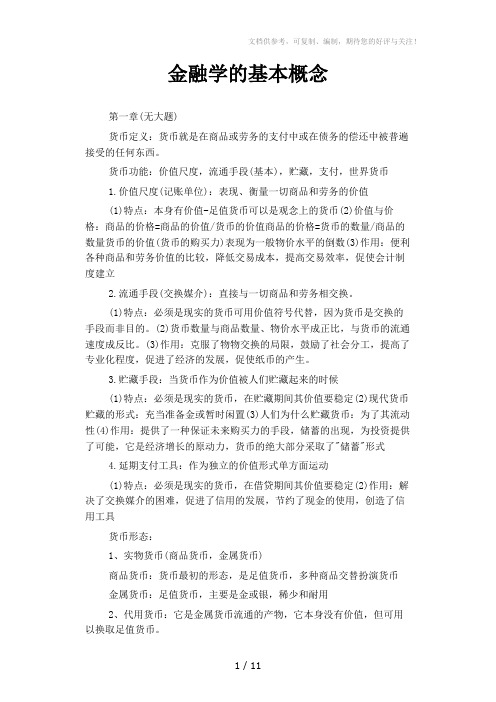
金融学的基本概念第一章(无大题)货币定义:货币就是在商品或劳务的支付中或在债务的偿还中被普遍接受的任何东西。
货币功能:价值尺度,流通手段(基本),贮藏,支付,世界货币1.价值尺度(记账单位):表现、衡量一切商品和劳务的价值(1)特点:本身有价值-足值货币可以是观念上的货币(2)价值与价格:商品的价格=商品的价值/货币的价值商品的价格=货币的数量/商品的数量货币的价值(货币的购买力)表现为一般物价水平的倒数(3)作用:便利各种商品和劳务价值的比较,降低交易成本,提高交易效率,促使会计制度建立2.流通手段(交换媒介):直接与一切商品和劳务相交换。
(1)特点:必须是现实的货币可用价值符号代替,因为货币是交换的手段而非目的。
(2)货币数量与商品数量、物价水平成正比,与货币的流通速度成反比。
(3)作用:克服了物物交换的局限,鼓励了社会分工,提高了专业化程度,促进了经济的发展,促使纸币的产生。
3.贮藏手段:当货币作为价值被人们贮藏起来的时候(1)特点:必须是现实的货币,在贮藏期间其价值要稳定(2)现代货币贮藏的形式:充当准备金或暂时闲置(3)人们为什么贮藏货币:为了其流动性(4)作用:提供了一种保证未来购买力的手段,储蓄的出现,为投资提供了可能,它是经济增长的原动力,货币的绝大部分采取了"储蓄"形式4.延期支付工具:作为独立的价值形式单方面运动(1)特点:必须是现实的货币,在借贷期间其价值要稳定(2)作用:解决了交换媒介的困难,促进了信用的发展,节约了现金的使用,创造了信用工具货币形态:1、实物货币(商品货币,金属货币)商品货币:货币最初的形态,是足值货币,多种商品交替扮演货币金属货币:足值货币,主要是金或银,稀少和耐用2、代用货币:它是金属货币流通的产物,它本身没有价值,但可用以换取足值货币。
3、信用货币(硬币,纸币,存款货币):它本身没有价值,也不能用以兑换足值货币。
它的发行由国家政府垄断,变成法偿币。
消费金融概念

消费金融概念消费金融概念简述概念定义消费金融是指通过金融机构提供的金融产品和服务,为个人和家庭提供融资、分期付款等方式,以满足消费需求的金融业务。
消费金融旨在方便消费者获取资金,帮助消费者实现个人消费和生活改善。
相关内容消费金融包括以下主要内容:1. 贷款服务•贷款是消费金融的核心业务之一,包括个人信用贷款、购车贷款、购房贷款等。
•个人信用贷款是向个人提供的无需抵押担保的借款服务,主要用于满足个人日常消费、旅游、教育等需求。
•购车贷款是帮助消费者购买汽车的贷款服务,可分期还款。
•购房贷款是帮助消费者购买住房的贷款服务,按照合同约定分期还款。
2. 分期付款服务•分期付款是消费金融的常见服务之一,消费者可以选择将购物费用分期支付。
•分期付款服务往往需要在购物场所或电商平台与金融机构合作,为消费者提供方便的分期付款方式。
3. 信用卡服务•信用卡是消费金融中常见的支付方式之一,消费者可以使用信用卡在各种商户进行消费,然后按照约定的还款方式还款。
•信用卡在一定的信用额度内提供了消费者便捷的支付方式,还可享受积分返利、分期付款等服务。
4. 积分兑换服务•积分兑换是消费金融中的附加服务,消费者可以通过在特定商户消费或使用信用卡获得积分,然后将积分兑换为商品、礼品或优惠券等。
•积分兑换服务旨在奖励消费者的忠诚度,提升消费者的购买满意度。
5. 金融科技创新•近年来,消费金融领域逐渐兴起了金融科技创新,如互联网消费金融、移动支付等。
•互联网消费金融将传统的金融业务与互联网技术相结合,提供更便捷的消费金融服务。
•移动支付则通过手机等移动终端进行支付,使消费者可以随时随地进行消费。
以上是有关消费金融概念及相关内容的简要介绍。
消费金融旨在满足消费者的消费需求,通过提供各种金融产品和服务,为消费者提供更便捷的资金支持,帮助消费者改善生活。
消费金融行业的发展也为金融科技创新提供了更多机遇与挑战。
6. 投资理财服务•消费金融领域也涉及到个人投资理财的服务,如基金、理财产品等。
- 1、下载文档前请自行甄别文档内容的完整性,平台不提供额外的编辑、内容补充、找答案等附加服务。
- 2、"仅部分预览"的文档,不可在线预览部分如存在完整性等问题,可反馈申请退款(可完整预览的文档不适用该条件!)。
- 3、如文档侵犯您的权益,请联系客服反馈,我们会尽快为您处理(人工客服工作时间:9:00-18:30)。
暑期实习1.EBIT,全称Earnings Before Interest and Tax,即息税前利润,从字面意思可知是扣除利息、所得税之前的利润。
计算公式有两种,EBIT=净利润+所得税+利息,或EBIT=经营利润+投资收益+营业外收入-营业外支出+以前年度损益调整。
2.EBITDA,全称Earnings Before Interest, Tax, Depreciation and Amortization,即息税折旧摊销前利润,是扣除利息、所得税、折旧、摊销之前的利润。
计算公式为EBITDA=净利润+所得税+利息+折旧+摊销,或EBITDA=EBIT+折旧+摊销。
3.The special items – comprising effects that are non-recurring or do not regularly recur orattain similar magnitudes – are detailed in the following table. “ebitda,” “ebitda before special items” and “ebit before special items” are not defined in the International Financial Reporting Standards and should therefore be regarded only as supplementary information.The company considers ebitda before special items to be a more suitable indicator of operating performance since it is not affected by depreciation, amortization, impairments or special items. By reporting this indicator, the company aims to give readers a clearer picture of the results of operations and ensure greater comparability of data over time. The ebitda margin before special items, which is the ratio of ebitda before special items to sales, serves as a relative indicator for the internal and external comparison of operational earning power.4.Special items非经常发生项,并没有在国际标准报表中呈现,是自己的项目;公司认为EBITDA before special items是一个更合适的指标,因为它不受折旧、摊销、损益的影响。
5.IFRS,International Financial Reporting Standards 国际财务报告准则;6.Generally Accepted Accounting Principles是一般公认会计原则,1937年美国会计程序委员会(CAP)发表第一号会计研究公告,开创了由政府机关或行业组织颁布“一般通用会计”的先河。
7.周转率=销售收入占应收账款的比重;应收账款如果越多,占得比重越高(周转率越小、周转天数越大),说明下游企业的钱收不上来,企业愿意延长下游企业的还款时间,行业不景气;8.为什么看毛利?毛利是企业的销售收入和生产成本相互作用的结果,是衡量企业长期经营能力的重要指标。
相比营业利润、净利润等指标,它们包含营业外收入支出,其中企业可以通过卖房等手段增加当年的净利润,所以受影响程度比较大,并且每个企业的经营状况不一样,有的企业三费高,会影响我们对企业盈利能力的判断。
三费=销售费用+管理费用+财务费用毛利润=(销售收入-销售成本)/销售收入,主要看产品销售时的盈利能力,毛利平稳,毛利增加,毛利减少,都可以很直观的看出公司最近产品的盈利能力。
营业利润=销售收入-销售成本+其他业务收入-其他业务成本-三大费用-营业税金,看公司整体日常经营业务的盈利能力,看看销售贡献出来的毛利,是不是被三大费给吃完了,公司的日常运营成本是比较合理还是太高了。
还可以看看公司有没有其他利润的来源,比如有房产的公司可以出租场所来赚点其他业务收入。
这是公司日常经营时应该要保证的一个平稳的数字。
利润总额=营业利润+营业外收入-营业外支出,看公司整体的盈利,有没有被各种意外抢走利润,比如赔偿,罚款。
利润总额变动过大会影响日常经营的成果,和公司的稳定性也有关系。
净利润=利润总额-所得税费用,最后可以分配给股东的钱。
国外采用的指标EBIT,即息税前利润。
9.化工行业的行情已经持续了一年半左右的时间,像化工、石油、机械这些板块都具有很强的周期性(从需求旺盛,到资金流入,到扩大生产,到产能过剩),所以现在寻找一些具备较强成长性的小票。
1.相同类别的信息要放在一块,公司情况、产能、下游产品、市场情况;2.对其它公司的研究报告中的“年份、月份时间”、“预测”等类字眼要敏感,出现的话说明你用的是别人的报告;3.对于年报中,报告期等字眼要敏感,不要出现此类字眼;4.对于市场中的产品的价格等要敏感,要么不写,要么更新至最新的数据;5.做完之后检查一遍内在逻辑框架;上海主板股票代码:600XXX深圳主板股票代码:000XXX深圳中小板股票代码:002XXX创业板股票代码:300XXX新三板股票代码:83XXXX或43XXXX中关村老三板:退市的企业股份继续流通的场所主板入市要求:连续三年盈利,累计盈利超过3000万人民币,1990-2017共有1600家左右企业在主板上市;创业板入市要求:持续经营三年;新三板企业多为高科技创新型新企业,持续经营满两年可上市,无盈利门槛限制;三板的股票流通性不高,通常的概念里不包括三板主板:上市的企业具有下列特点:市场占有率高、规模较大、基础较好、高收益、低风险的大型优秀企业。
中小板:主要服务于即将或已进入成熟期、盈利能力强、但规模较主板小的中小企业。
创业板:是以自主创新企业及其他成长型创业企业为服务对象,主要为“两高”、“六新”企业,即高科技、高成长性、新经济、新服务、新农业、新能源、新材料、新商业模式企业。
新三板:主要为创新型、创业型、成长型中小微企业发展服务。
(实际情况则比较乱)相同的股票,更全面的数据,更新颖的逻辑,更详实的内容得出最正确的预测结果,等待结果被验证。
少数股东权益:简称少数股权。
在母公司拥有子公司股份不足100%,即只拥有子公司净资产的部分产权时,子公司股东权益的一部分属于母公司所有,即多数股权,其余一仍属外界其他股东所有,由于后者在子公司全部股权中不足半数,对子公司没有控制能力,故被称为少数股权。
①没有达到控股比例的公司股东权益,即公司51%以上控股权益外的其他股东权益。
②公司股东在未完全控股的分公司、子公司中的权益。
在合并附属公司的财务报表时,附属公司中的非本公司股份权益被认同为公司对外负债。
账面价值( 账面净值)(carrying value、book value)是指按照会计核算的原理和方法反映计量的企业价值。
《国际评估准则》指出,企业的账面价值,是企业资产负债表上体现的企业全部资产(扣除折旧、损耗和摊销)与企业全部负债之间的差额,与账面资产、净值和股东权益公允价值(Fair Value)亦称公允市价、公允价格。
熟悉市场情况的买卖双方在公平交易的条件下和自愿的情况下所确定的价格,或无关联的双方在公平交易的条件下一项资产可以被买卖或者一项负债可以被清偿的成交价格。
在公允价值计量下,资产和负债按照在公平交易中,熟悉市场情况的交易双方自愿进行资产交换或者债务清偿的金额计量。
购买企业对合并业务的记录需要运用公允价值的信息。
在实务中,通常由资产评估机构对被并企业的净资产进行评估。
商誉通常是指企业在同等条件下,能获得高于正常投资报酬率所形成的价值。
这是由于企业所处地理位置的优势、或是由于经营效率高、历史悠久、人员素质高等多种原因,与同行企业比较,可以获得超额利润。
表观消费量是指当年产量加上净进口量(当年进口量减出口量)。
非同一控制下企业合并:企业合并可以分为同一控制下企业合并与非同一控制下企业合并,而同一控制下的企业合并实质上是同一集团下企业财产与资源的重新分配。
所以严格意义上的企业合并应该指的是非同一控制下企业合并。
逆回购央行逆回购是指中国人民银行向一级交易商购买有价证券,并约定在未来特定日期将有价证券卖还给一级交易商的交易行为。
就是获得质押的债券,把钱借给商业银行。
目的主要是向市场释放流动性,当然,同时可以获得回购的利息收入。
操作就是央行把钱借给商业银行,商业银行把债券质押给央行,到期的时候,商业银行还钱,债券回到商业银行账户上。
在岸人民币汇率:指中国大陆的人民币即期汇率,由中国人民银行授权中国外汇交易中心公布。
由于在岸市场实施的强制结汇制度,以及央行在银行间外汇市场扮演的特殊角色,在岸人民币汇率并不能反映市场供需,而是一个受管控的汇率。
离岸人民币汇率:所谓离岸人民币市场,是指中国大陆之外,可经营人民币存、放款业务的市场。
目前最活跃的人民币离岸市场在香港,其他如新加坡、伦敦、台湾也在积极争取人民币离岸中心的角色。
香港人民币市场存在即期汇率、远期可交割合约(DF)与远期不可交割合约(NDF)三种汇率,这里主要研究的是即期汇率。
通常国外希望人民币大幅升值,而国内正好相反,所以离岸汇率高于在岸汇率。
1.Cost of debt 借贷成本;2.Equity: the capital that a company has from shares rather than from loans;3.WACC 加权平均资本成本公司从外部获取资金的来源主要有两种:股权和债务。
因此一个公司的资本结构主要包含三个成分: 优先股,普通股和负债(常见的有债券和期票)。
加权平均资本成本考虑资本结构中每个成分的相对权重并体现出该公司的新资产的预期成本。
4.Discount rate 贴现率5.NPV or NPW (Net Present Value) (Net Present Worth)净现值is a measurement of profitcalculated by subtracting the present values (PV) of cash outflows (including initial cost) from the present values of cash inflows over a period of time.NPV/NPW = cash inflows (present values) – cash outflows (present values)6.APV (Adjusted Present Value) The adjusted present value is the net present value (NPV) of aproject or company if financed solely by equity plus the present value (PV) of any financing benefits, which are the additional effects of debt. By taking into account financing benefits, APV includes tax shields such as those provided by deductible interest.7.FTE (FTE/Free Cash flow to Equity) is a metric of how much cash can be distributed to theequity shareholders of the company as dividends or stock buybacks—after all expenses,reinvestments, and debt repayments are taken care of. Whereas dividends are the cash flows actually paid to shareholders, the FCFE is the cash flow simply available to shareholders.8.time value of money is the greater benefit of receiving money now rather than later. It isfounded on time preference.9.DCF (Discounted cash flow) is a method of valuing a project, company, or asset using theconcepts of the time value of money. All future cash flows are estimated and discounted by using cost of capital to give their present values (PVs). The sum of all future cash flows, both incoming and outgoing, is the net present value (NPV), which is taken as the value of the cash flows in question.10.American call and European call看涨期权又称认购期权、买进期权、购买期权、买方期权、买权、延买期权,或敲进期权。
